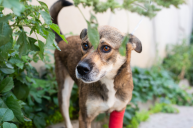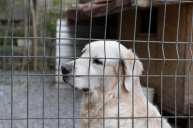Bringing home a rescue dog? Make sure you have a routine in place.
The first day in a new home can be stressful for any dog. However, for rescue dogs, it may be very difficult to transition to a new environment and a new family. Some rescues spent time with a foster family while others may have waited to be adopted in a shelter or boarding facility. An established rescue pet routine may help the dog feel at home and acclimate faster.
What To Do Before Bringing Home A Rescue
Dog owners have always had some prep work to do when bringing home new furry family members. But it is very important that your new rescue doggy feels at home as soon as they get there. Before you pick up your new friend, grab the following items online or at your local pet store:
- Water bowl
- ?Food bowl
- Dog food
- Dog treats
- Crate/ kennel
- Chew toys
- Pet bed
- ID tag
- Baby gate (for off-limit areas)
Your rescue dog may have some separation anxiety when getting to your home. Having the necessities in place before bringing them home will allow you to be at home and help them acclimate to their new space.
Setting Up Your Rescue Pet Routine
RELATED: Dogs Separated at Adoption Randomly Met, And We're Still Crying
These sweet pups are so excited when they realize they are going home and leaving the shelter for good! It is so heartwarming when they get in the car and see that they are not just going out for a walk! As happy as these pups are to leave, they may get a little shy once they get to their new homes and thats where a solid routine comes in handy.
A routine is useful whenever you bring a new dog home, but it is essential for when you bring a rescue pet home. Your new rescue dog will be excited to leave the shelter or foster home but may be a little unsure of their new surroundings, especially the first time you bring them home.
Before your shelter dog comes home, iron out the details of its daily routine. Plan for who will feed the dog and their feeding schedule. Decide who will be walking your dog and when you plan on taking your new pooch for walks. Think about what playtime will look like and whether or not you will take your dog to the dog park or not.
Also, decide where your new pet is going to be sleeping at night. If the rescue pet is a new puppy, they may not have any sleep training, or they may have begun crate training. Crates give your rescue pet a safe place to call their own, and it can be a quiet place if your dog needs to separate themselves from other pets in the household or is feeling overwhelmed. Having a safe space will also help them adjust better.
Decide whether or not your new pet will be allowed to sit on the furniture in your house, and decide if you are going to have any off-limit areas in your home.
While many of these pre-items may seem over the top, it is necessary to provide your rescue pet with a routine and some stability in their new home. You never know exactly what the cat or dog's life may have been like before coming to your home.
Take Time To Help Them Adjust
According to the Humane Society, it's best to plan the arrival of your new best friend around a weekend or when you have time to help them adjust to their new life. The first night can be rough but setting the routine in motion and adding in positive reinforcement with some treats can help make it go more smoothly.
The first week will be a major adjustment for everyone in the household. Everyone will settle better if you or someone else in your house is home. Keep things calm, quiet, and consistent during that time. It is best not to have over socialization during the first week or so. Avoid going to stores and dog parks for a little while so you will not scare them.
Over the first couple of weeks, you will start to see your rescue pets' true personality come out. Dane County Humane Society suggests that you follow the Rule of Three. In the first three days, your new pet will go through the decompression phase. Everything at your home is new, exciting, and can also be a little scary for a shelter dog. Have a lot of patience and don't jump to any conclusions about possible behavior issues. Your new furry friend will start to settle down as they feel more comfortable.
When we brought home our rescue, Dakota, she ran out into the backyard to go potty and immediately hid underneath one of our outdoor chairs. The poor little thing was not sure what to do with all the space her new backyard had to offer, so she found the smallest place she could go. We sat down with her and waited for her to come to us. In the next three weeks, she started to settle in and began responding to basic commands, and was doing well with her house training.
Most dogs and cats will start to feel comfortable within that three-week period. They will learn their routine and will be picking up on basic obedience commands. You also will be able to see which areas of dog training you may need to work with them on or go to training classes for.
As your new pet gets settled, keep your meal times and walks to the same time each day. If you need to leave to go to work or errands, try to keep your coming and going at the same time to keep things consistent. Also, when you leave make sure your pet has something productive to do. The Humane Society suggests giving them a puzzle food bowl or a treat-stuffed toy.
At the three-month mark, your rescue pet's routine will be going along pretty smoothly. While everything might not be perfect, your pet will understand that they are now in their forever home and will have built a trusting relationship with you. Just remember bringing home a new pet takes a lot of patience and understanding. The transition won't be seamless, but if you set a routine there will be a lot less chaos.
What did you do for your rescue pet's routine? Tell us on our Wide Open Pets Facebook page!




